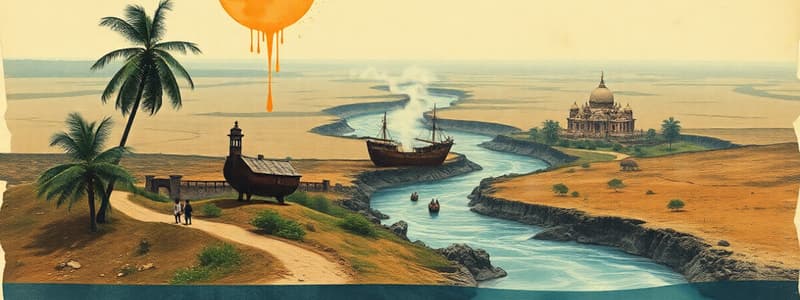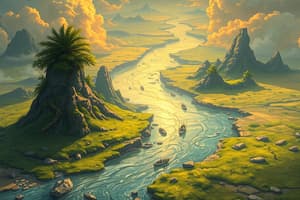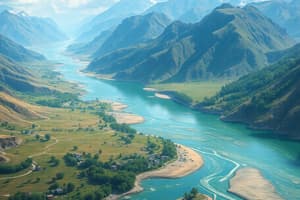Podcast
Questions and Answers
What river is believed to have traversed the entire longitudinal extent of the Himalaya during the Miocene period?
What river is believed to have traversed the entire longitudinal extent of the Himalaya during the Miocene period?
Indo-Brahma river.
Which area is referred to as Dardistan in the context of the Indo-Brahma river?
Which area is referred to as Dardistan in the context of the Indo-Brahma river?
The region where the Indus river enters into Pakistan near Chilas.
How many main drainage systems did the Indo-Brahma river dismember into?
How many main drainage systems did the Indo-Brahma river dismember into?
Three main drainage systems.
What geological event is believed to have caused the dismemberment of the Indo-Brahma river?
What geological event is believed to have caused the dismemberment of the Indo-Brahma river?
What is the name given to the five rivers of Punjab that join the Indus river?
What is the name given to the five rivers of Punjab that join the Indus river?
What are the main depositional features formed by rivers entering the plains?
What are the main depositional features formed by rivers entering the plains?
Why does the Kosi river bring such a large quantity of sediments from its upper reaches?
Why does the Kosi river bring such a large quantity of sediments from its upper reaches?
How does the discharge of the Kosi river fluctuate, and when does it receive maximum water?
How does the discharge of the Kosi river fluctuate, and when does it receive maximum water?
What are some positive and negative effects of flooding caused by Himalayan rivers?
What are some positive and negative effects of flooding caused by Himalayan rivers?
What is the origin and significance of the Indus River in the Himalayan drainage system?
What is the origin and significance of the Indus River in the Himalayan drainage system?
What is the significance of the Ganga River in India?
What is the significance of the Ganga River in India?
Where does the Kosi River originate?
Where does the Kosi River originate?
What are the main tributaries of the Ganga mentioned?
What are the main tributaries of the Ganga mentioned?
Describe the course of the Ramganga River.
Describe the course of the Ramganga River.
Where does the Damodar River flow and where does it join the Ganga?
Where does the Damodar River flow and where does it join the Ganga?
What is the Tsangpo known for in southern Tibet?
What is the Tsangpo known for in southern Tibet?
Which river joins the Tsangpo in the plains before it meets the Ganga?
Which river joins the Tsangpo in the plains before it meets the Ganga?
What is the name of the river when it emerges from the foothills under the name Siang?
What is the name of the river when it emerges from the foothills under the name Siang?
Name one major left bank tributary of the Brahmaputra.
Name one major left bank tributary of the Brahmaputra.
What geological events have shaped the present drainage systems of Peninsular India?
What geological events have shaped the present drainage systems of Peninsular India?
Flashcards
Himalayan Rivers
Himalayan Rivers
River systems originating in the Himalayas, characterized by varying course characteristics, sediment transport, and frequent shifts.
Indus River System
Indus River System
A major river system in the Himalayas, originating in the Tibetan Plateau and flowing through India, covering a large area.
River Kosi
River Kosi
A Himalayan river known for its frequent course changes, bringing significant sediments from its upper reaches and depositing them on the plains.
River Course Changes
River Course Changes
Signup and view all the flashcards
Sediment Transport
Sediment Transport
Signup and view all the flashcards
Shiwalik River
Shiwalik River
Signup and view all the flashcards
Indus River Tributaries
Indus River Tributaries
Signup and view all the flashcards
Panjnad
Panjnad
Signup and view all the flashcards
Dardistan Region
Dardistan Region
Signup and view all the flashcards
Miocene Period
Miocene Period
Signup and view all the flashcards
Ganga River System
Ganga River System
Signup and view all the flashcards
Yamuna Tributary
Yamuna Tributary
Signup and view all the flashcards
Kosi River
Kosi River
Signup and view all the flashcards
Ganga Tributaries
Ganga Tributaries
Signup and view all the flashcards
Damodar River
Damodar River
Signup and view all the flashcards
Brahmaputra River Origin
Brahmaputra River Origin
Signup and view all the flashcards
Brahmaputra Tributaries
Brahmaputra Tributaries
Signup and view all the flashcards
Peninsular Drainage Shaping Events
Peninsular Drainage Shaping Events
Signup and view all the flashcards
Brahmaputra's Major Tributaries
Brahmaputra's Major Tributaries
Signup and view all the flashcards
Tsangpo River
Tsangpo River
Signup and view all the flashcards
Study Notes
Drainage System
- Rivers, nalas, and channels drain excess water during the rainy season.
- Blocked or ill-defined channels cause flooding.
- Drainage refers to water flowing through defined channels.
- A drainage system is a network of channels.
- Drainage patterns are determined by geology, topography, and water flow.
- Catchment area is the area a river collects water from.
- Drainage basin includes the river and its tributaries.
- Drainage patterns include dendritic (tree-like), radial, trellis, and centripetal (flowing into a center).
Important Drainage Patterns
- Dendritic: River branching like a tree, common in northern plains.
- Radial: Rivers originating from a hill, flowing in all directions, e.g., Amarkantak range.
- Trellis: Primary tributaries parallel to each other, secondary tributaries perpendicular, forming a trellis pattern.
- Centripetal: Rivers flowing from all directions into a lake or depression.
Major Rivers of India
- Map showing major rivers of India, including the Indus, Ganga, and Brahmaputra, with their tributaries, and the water divide.
Himalayan Drainage
- Rivers originating in the Himalayas, such as the Ganga, Indus, and Brahmaputra, are perennial due to glacier melt.
- These rivers carve deep gorges and V-shaped valleys.
- These rivers, like the Ganga and Indus, flow towards the Bay of Bengal and the Arabian Sea, respectively.
Peninsular Drainage
- Older than Himalayan drainage, with mostly fixed courses.
- Rivers flow in broad, shallow valleys, commonly flowing west to east, such as the Godavari, Krishna, and Kaveri.
- Rivers are generally non-perennial.
- The Narmada and Tapi are exceptions, flowing west to the Arabian Sea.
- These rivers are affected by geological events, like subsidence and upheavals, resulting in their pattern.
River Basins and Watersheds
- River basins are large areas drained by a river and its tributaries.
- Watersheds are the areas separating river basins.
- A watershed affects an entire basin.
Studying That Suits You
Use AI to generate personalized quizzes and flashcards to suit your learning preferences.




